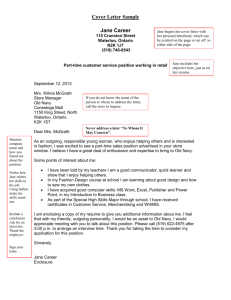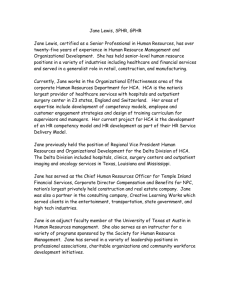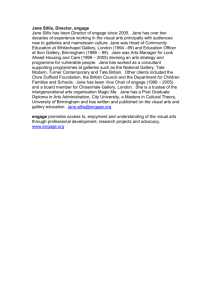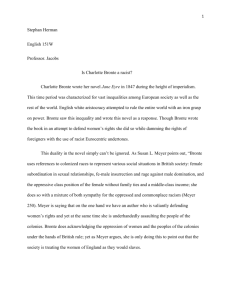Jane Eyre Chapters I-X Chapter I How does Bronte create sympathy
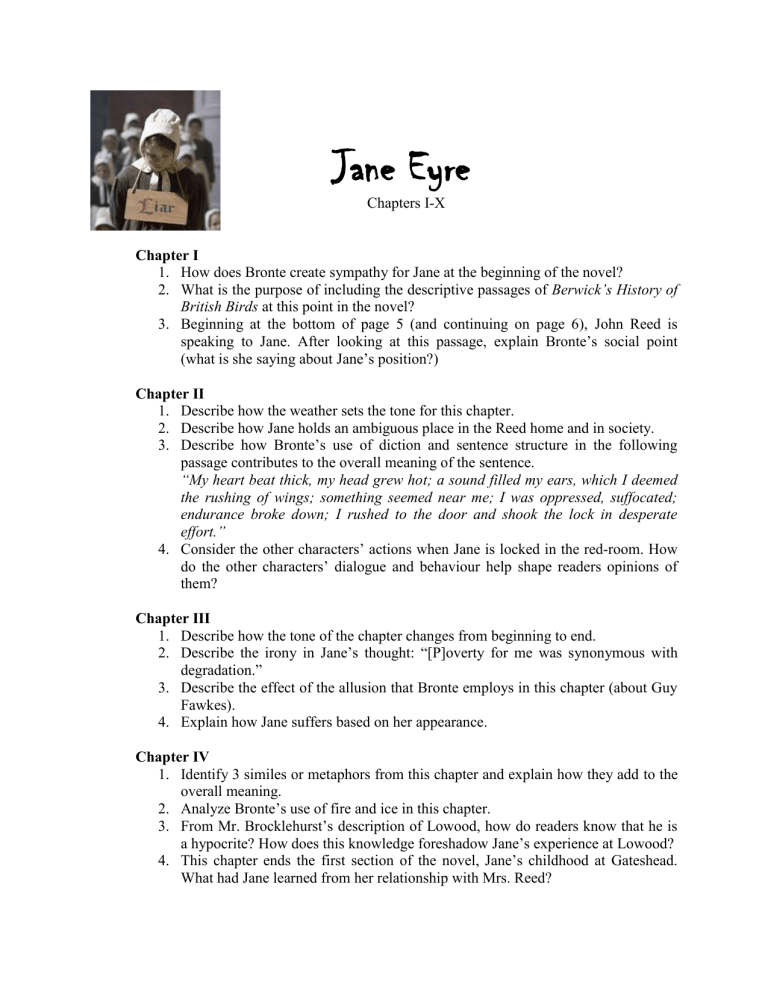
Jane Eyre
Chapters I-X
Chapter I
1.
How does Bronte create sympathy for Jane at the beginning of the novel?
2.
What is the purpose of including the descriptive passages of
Berwick’s History of
British Birds at this point in the novel?
3.
Beginning at the bottom of page 5 (and continuing on page 6), John Reed is speaking to Jane. After looking at this passage, explain Bronte’s social point
(what is she saying about Jane’s position?)
Chapter II
1.
Describe how the weather sets the tone for this chapter.
2.
Describe how Jane holds an ambiguous place in the Reed home and in society.
3.
Describe how Bronte’s use of diction and sentence structure in the following passage contributes to the overall meaning of the sentence.
“My heart beat thick, my head grew hot; a sound filled my ears, which I deemed the rushing of wings; something seemed near me; I was oppressed, suffocated; endurance broke down; I rushed to the door and shook the lock in desperate effort.”
4.
Consider the other characters’ actions when Jane is locked in the red-room. How do the other characters’ dialogue and behaviour help shape readers opinions of them?
Chapter III
1.
Describe how the tone of the chapter changes from beginning to end.
2.
Describe the irony in Jane’s thought: “[P]overty for me was synonymous with degradation.”
3.
Describe the effect of the allusion that Bronte employs in this chapter (about Guy
Fawkes).
4.
Explain how Jane suffers based on her appearance.
Chapter IV
1.
Identify 3 similes or metaphors from this chapter and explain how they add to the overall meaning.
2.
Analyze Bronte’s use of fire and ice in this chapter.
3.
From Mr. Brocklehurst’s description of Lowood, how do readers know that he is a hypocrite? How does this knowledge foreshadow Jane’s experience at Lowood?
4.
This chapter ends the first section of the novel, Jane’s childhood at Gateshead.
What had Jane learned from her relationship with Mrs. Reed?
Chapter V
1.
In general, consider the connotations that Bronte employs in this chapter. Is the overall feeling of the language in this chapter positive or negative? Cite examples and explain Bronte’s strategy.
2.
Contrast Bronte’s description of Miss Temple with that of Mr. Brocklehurst.
Chapter VI
1.
Why does Helen Burns endure her harsh treatment at Lowood?
2.
Analyze the difference between Jane and Helen’s beliefs about Christianity.
3.
What does Helen tell Jane about her feelings toward the Reed family?
Chapter VII
1.
Examine Bronte’s use of light and dark in this chapter.
Chapter VIII
2.
What is the one thing that Jane truly wants?
3.
Contrast Helen and Jane’s views of solitude.
4.
Explain how Jane’s temperament begins to change in this chapter because of her relationship with Helen and Miss Temple.
Chapter IX
1.
Explain the symbolic meanings of the names of the places where Jane has lived so far: Gateshead and Lowood.
2.
Explain the figurative language Bronte uses: “[D]isease had thus become and inhabitant of Lowood, and death its frequent visitor.” What effect does it have?
3.
At this point in her life, Jane has encountered only two significant religious figures. Explain the effect that each has on Jane and her view of religion.
Chapter X
1.
An aporia occurs when a character speaks directly to oneself or to the reader, especially when a character is trying to solve a dilemma or decide on a plan.
Explain when and why Bronte uses aporia in this chapter.
2.
Bronte uses a polysyndeton
, the repetition of the conjunction “and”, in the following passage. What effect does its use have?
“I had had no communication by letter or message with the outer world: school rules, school duties, school habits and notions, and voices, and faces, and phrases, and costumes, and preferences, and antipathies: such was what I knew of existence.”
3.
How does Miss Temple’s marriage affect Jane?
4.
Discuss Jane’s one real concern about venturing away from Lowood.


